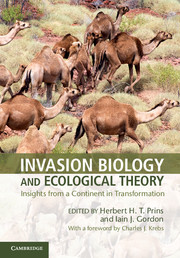Book contents
- Frontmatter
- Contents
- List of Contributors
- Foreword
- 1 Testing hypotheses about biological invasions and Charles Darwin’s two-creators rumination
- Part I Ancient invaders
- 2 Australia’s Acacia: unrecognised convergent evolution
- 3 The mixed success of Mimosoideae clades invading into Australia
- 4 Perspectives from parrots on biological invasions
- 5 Invasion ecology of honeyeaters
- 6 The invasion of terrestrial fauna into marine habitat: birds in mangroves
- 7 The biological invasion of Sirenia into Australasia
- 8 Flying foxes and drifting continents
- 9 Invasion ecology of Australasian marsupials
- 10 Murine rodents: late but highly successful invaders
- 11 Drift of a continent: broken connections
- 12 The development of a climate: an arid continent with wet fringes
- Part II Modern invaders
- Index
- References
6 - The invasion of terrestrial fauna into marine habitat: birds in mangroves
from Part I - Ancient invaders
Published online by Cambridge University Press: 05 February 2014
- Frontmatter
- Contents
- List of Contributors
- Foreword
- 1 Testing hypotheses about biological invasions and Charles Darwin’s two-creators rumination
- Part I Ancient invaders
- 2 Australia’s Acacia: unrecognised convergent evolution
- 3 The mixed success of Mimosoideae clades invading into Australia
- 4 Perspectives from parrots on biological invasions
- 5 Invasion ecology of honeyeaters
- 6 The invasion of terrestrial fauna into marine habitat: birds in mangroves
- 7 The biological invasion of Sirenia into Australasia
- 8 Flying foxes and drifting continents
- 9 Invasion ecology of Australasian marsupials
- 10 Murine rodents: late but highly successful invaders
- 11 Drift of a continent: broken connections
- 12 The development of a climate: an arid continent with wet fringes
- Part II Modern invaders
- Index
- References
Summary
Mangroves are woody plants that occur at the land and sea interface and inhabit the upper intertidal zones of saltwater areas, primarily in tropical and subtropical regions (Tomlinson 1986; Hutchings and Saenger 1987). Since mangrove forests are an ecotone between terrestrial and marine realms, they have both vegetative strata that are similar to many inland terrestrial ecosystems as well as an intertidal benthic component that is representative of the marine environment. As such, mangroves exhibit a very steep gradient from fresh to saline water (Mitsch and Gosselink 2000). The combination of terrestrial and marine environments occurring within mangrove forests can present many difficulties, in terms of abiotic stressors, such as salt water instead of fresh water and twice daily tidal inundations, for terrestrial species attempting to colonise this habitat (Mitsch and Gosselink 2000; Luther and Greenberg 2009). Salt water could present physiological challenges for some species and high tides could present challenges for ground-nesting and terrestrial species that prefer dry land to aquatic systems. Finally, competition or predation from estuarine and marine species has the potential to inhibit the colonisation of mangrove ecosystems by some terrestrial species. The aforementioned abiotic and biotic stressors could prevent some terrestrial species from invading mangrove habitats, which makes mangroves an excellent system in which to investigate the biological invasion of species into novel habitats.
Based on floral species composition, mangroves occur in two distinct biogeographical regions, the Indo-West Pacific and the Atlantic–Caribbean–East Pacific. These regions can be further subdivided into six distinct subregions: Eastern Pacific, West Atlantic–Caribbean, West African, East African, Indo-Malaysian and Australian (Duke 1992) (see Figure 6.1). The subregions of Australia and Indio-Malaysia have more than twice as many mangrove tree species as any other subregion (Duke 1992). Mangrove forests are one of the most productive ecosystems in the world with ample food resources for both marine and terrestrial animals (Mitsch and Gosselink 2000). However, mangroves are also cited as extremely depauparate of biodiversity when compared to other habitats (Tomlinson 1986; Hutchings and Saenger 1987; Hogarth 2007).
- Type
- Chapter
- Information
- Invasion Biology and Ecological TheoryInsights from a Continent in Transformation, pp. 103 - 117Publisher: Cambridge University PressPrint publication year: 2014

